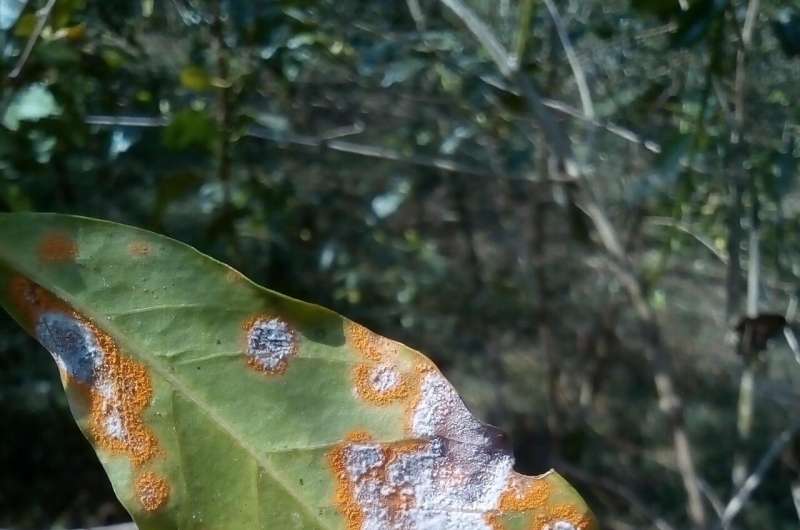Fungus that eats fungus could help coffee farmers

Coffee rust is a parasitic fungus and a big problem for coffee growers around the world. A study in the birthplace of coffee—Ethiopia—shows that another fungus seems to have the capacity to supress the rust outbreaks in this landscape.
"Coffee leaf rust is a fungal disease that is a problem for coffee growers around the world, especially on Arabica coffee, which accounts for three quarters of global coffee production and has the finest cup quality. There is a need to learn more about natural solutions instead of just applying pesticides," says Kristoffer Hylander, professor at the Department of Ecology, Environment and Plant Sciences (DEEP) at Stockholm University.
Coffee leaf rust is caused by a parasitic fungus that attacks the leaves of the coffee shrub. In some areas it has previously been known to have a potential natural enemy—a hyperparasitic fungus that grows on top of the rust. However, very little is known about its biology and to what extent it could suppress the rust. This is the first study on the interaction between the rust and its hyperparasite in Ethiopia, the birthplace of Arabica coffee. The coffee plant, the rust and its hyperparasite may have coevolved in Ethiopia for a long time.
Coffee leaf rust generally increases in abundance from the rainy to the dry season. However, it seems like this increase is reduced in places where the hyperparasite is common:

"This is an indication that the hyperparasite may have the potential to reduce outbreaks of the rust in areas where both the rust and the hyperparasite exist together," says Ayco Tack, associate professor at the Department of Ecology, Environment and Plant Sciences (DEEP) at Stockholm University.
It seems like the rust and the hyperparasite thrive in slightly different environments, with the rust adapting well in less humid places and the hyperparasite favoring slightly more humid places such as coffee farms with more shade trees.
"This could be a win-win situation. By increasing the tree cover in coffee plantations with native shade tree species that maintain their leaves during the dry season, we could perhaps benefit both biodiversity and the hyperparasite," says Kristoffer Hylander, professor at the Department of Ecology, Environment and Plant Sciences (DEEP) at Stockholm University.

The authors did not investigate whether the presence of the hyperparasite could lead to better coffee yields, via its effect on rust. The hyperparasite might reduce leaf drop associated with severe rust infection, thus reducing the expected indirect negative effect of the rust on coffee yields.
"This would be one of the next important steps in this research, since yield of coffee (or revenue) matters most for the smallholder coffee farmers. Interestingly, Ethiopia does not seem to have as big a problem with coffee leaf rust as other coffee-producing countries—and it would be interesting to find out if the hyperparasite may be an explanation for this difference. It is also important to note that the effect of coffee leaf rust in this landscape might change with the current global climate change," says Beyene Zewdie, who recently defended his thesis on the ecology of coffee diseases in Ethiopia at the Department of Ecology, Environment and Plant Sciences (DEEP) at Stockholm University.
More detailed experimental studies are needed to explore the relationships between the rust and the hyperparasite. This could enable coffee growers to utilize the hyperparasite as a biological control for the coffee leaf rust in more intensively managed plantations where the rust epidemics are highly problematic.
More information: Beyene Zewdie et al, Temporal dynamics and biocontrol potential of a hyperparasite on coffee leaf rust across a landscape in Arabica coffee's native range, Agriculture, Ecosystems & Environment (2021).
Provided by Stockholm University

















